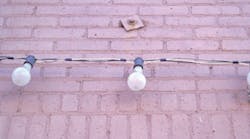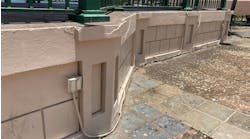Can you spot the Code violations?
Find the Answer
Gregory Enos, E.I.T., an electrical designer at Fanning/Howey Associates, Inc. in Michigan City, Ind., identified the following violations from the May photo. “Conductors need to be spliced with splicing devices identified for the use; electrical tape doesn't cut it [110.14(B)].Lampholders need to be suitable for a wet location (110.3), and where lampholders have terminals of a type that puncture the insulation and make contact with the conductors, they shall be attached only to conductors of the stranded type (225.24). Conductors used for festoon lighting shall be rubber-covered or thermoplastic (225.4).”
Brett Davis, a second-year apprentice with Local 380 in Collegeville, Pa., also identified problems that violated the requirements of 225.4 (Conductor Covering) and 225.24 (Outdoor Lampholders). “The lamps should possibly have been caged for protection,” he wrote.
In addition to identifying a violation of the requirements of 225.24, Mel Traughber, an apprentice electrician with R.I.C. Electric, Inc. in Lander, Wyo., noted the lampholders shall have guards (520.65), and the lampholder and lamps aren't suitable for installation in a wet location (410.4).




